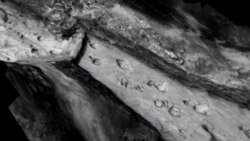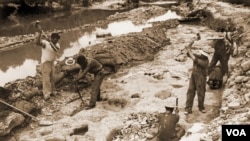A British research team has used 3-D imaging to reconstruct the entire route of the most famous fossilized dinosaur tracks ever, a so-called chase scene that was broken up and its pieces put into museums nearly 70 years ago.
Our story begins along a riverbed, about 120 million years ago in the age of the big dinosaurs. A large meat-eating three-toed theropod races close behind a long-neck sauropod, perhaps hungry for his dinner. Their feet press into the mud as they run, and after millions of years their fossil footprints are discovered along the Paluxy River in Glen Rose, Texas.
In 1940, those tracks were sent to museums but some were lost in transit.
Peter Falkingham, with London's Royal Veterinary College, and colleagues wanted to put the entire 45-meter long scene back together.
“As you can imagine a really long trackway from a dinosaur tells a lot more than two or three steps do,” Falkingham said.
The researchers used 17 photos and hand-drawn maps from Roland T. Bird’s 1940 excavation, coupled with 21st century technology called photogrammetry.
“Which is where you take several digital photographs of an object from multiple positions and the software looks for features in those photographs, matches those features and then basically uses math to figure out the camera positions," Falkingham said. "If we have lots of cameras we can get a 3-D model.”
They describe that model in the journal PLOS ONE.
“We can see both the theropod and the sauropod trackway coming down the trench that is being excavated out by Bird and his team," Falkingham said. "We can see the sand bags at the end where they were keeping the river off the tracks that they were excavating. Yeah, we can basically see everything that you could see in the photographs, but now we can see it in 3-D from many angles.”
While photogrammetry is gaining popularity in archeology, paleontology and other fields, Falkingham's study breaks new ground beyond a launch pad for future work.
“What we have done here, as far as I can tell for the first time, is reconstruct something that does not exist anymore, at least in that form and that is pretty exciting because museums hold tens of thousands of specimens and inevitably some get lost and damaged,” he said.
Falkingham says with photo documentation, what can follow are 3-D images and even 3-D printing to create the objects to study both physically and digitally.
But, for now if people want to see that famous dino chase from 120 million years ago, 3D technology can take them there.
Our story begins along a riverbed, about 120 million years ago in the age of the big dinosaurs. A large meat-eating three-toed theropod races close behind a long-neck sauropod, perhaps hungry for his dinner. Their feet press into the mud as they run, and after millions of years their fossil footprints are discovered along the Paluxy River in Glen Rose, Texas.
In 1940, those tracks were sent to museums but some were lost in transit.
Peter Falkingham, with London's Royal Veterinary College, and colleagues wanted to put the entire 45-meter long scene back together.
“As you can imagine a really long trackway from a dinosaur tells a lot more than two or three steps do,” Falkingham said.
The researchers used 17 photos and hand-drawn maps from Roland T. Bird’s 1940 excavation, coupled with 21st century technology called photogrammetry.
“Which is where you take several digital photographs of an object from multiple positions and the software looks for features in those photographs, matches those features and then basically uses math to figure out the camera positions," Falkingham said. "If we have lots of cameras we can get a 3-D model.”
They describe that model in the journal PLOS ONE.
“We can see both the theropod and the sauropod trackway coming down the trench that is being excavated out by Bird and his team," Falkingham said. "We can see the sand bags at the end where they were keeping the river off the tracks that they were excavating. Yeah, we can basically see everything that you could see in the photographs, but now we can see it in 3-D from many angles.”
While photogrammetry is gaining popularity in archeology, paleontology and other fields, Falkingham's study breaks new ground beyond a launch pad for future work.
“What we have done here, as far as I can tell for the first time, is reconstruct something that does not exist anymore, at least in that form and that is pretty exciting because museums hold tens of thousands of specimens and inevitably some get lost and damaged,” he said.
Falkingham says with photo documentation, what can follow are 3-D images and even 3-D printing to create the objects to study both physically and digitally.
But, for now if people want to see that famous dino chase from 120 million years ago, 3D technology can take them there.







